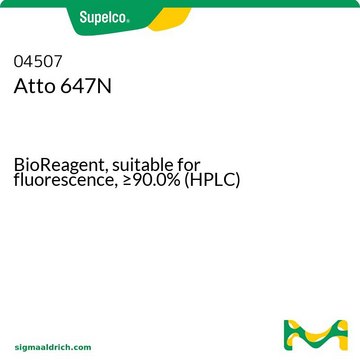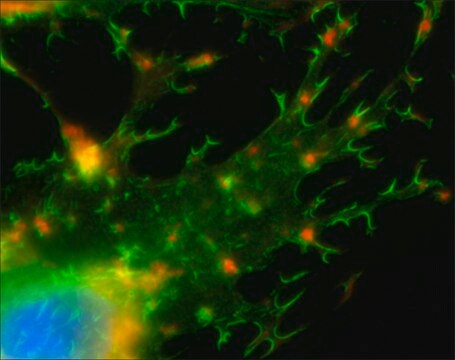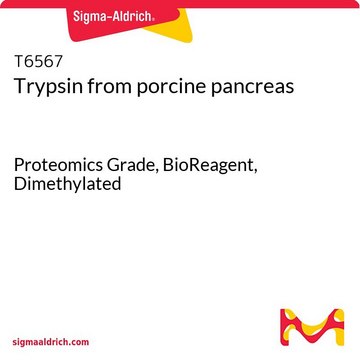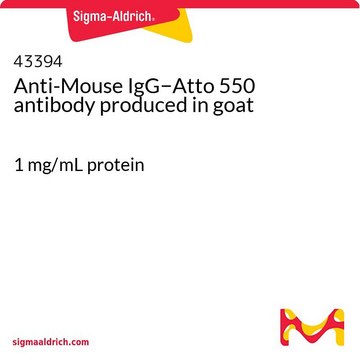65906
Phalloidin–Atto 647N
BioReagent, suitable for fluorescence, ≥80% (HPLC)
Synonym(s):
Atto 647N, Atto 647N-Phalloidin
Sign Into View Organizational & Contract Pricing
All Photos(1)
About This Item
UNSPSC Code:
12171501
NACRES:
NA.32
Recommended Products
product line
BioReagent
Quality Level
Assay
≥80% (HPLC)
manufacturer/tradename
ATTO-TEC GmbH
λ
in methanol
UV absorption
λ: 640-646 nm Amax
suitability
suitable for fluorescence
detection method
fluorometric
storage temp.
−20°C
Related Categories
General description
Phalloidin–Atto 647N is a new fluorescentlabel targeting the red spectral region. Atto 647N is a cationic dye, and postcoupling, it carries a net electrical charge of +1.Like most Atto labels, the absorption andfluorescence of Atto 647N are independent of pH between 2-11. Atto 647N issupplied in the form of a mixture containing two isomers having identicalfluorescence and absorption properties. Atto labels have rigid structures thatdo not show any cis-trans-isomerization.
Application
Phalloidin–Atto 647Nis designed to be used for labelling DNA, RNA, or proteins. Fluorescentconjugates of phalloidin are used to label actin filaments for histologicalapplications. Some structural features of phalloidin are required for thebinding to actin.
Features and Benefits
Characteristic features of the Phalloidin Atto488 are:
- StrongAbsorption.
- HighFluorescence quantum yield.
- HighPhotostability.
- MinimalTriplet formation.
- GoodSolubility.
- Excellent Ozone Resistance.
Legal Information
This product is for Research use only. In case of intended commercialization, please contact the IP-holder (ATTO-TEC GmbH, Germany) for licensing.
Not finding the right product?
Try our Product Selector Tool.
Signal Word
Danger
Hazard Statements
Precautionary Statements
Hazard Classifications
Acute Tox. 1 Inhalation - Acute Tox. 2 Dermal - Acute Tox. 2 Oral
Storage Class Code
6.1A - Combustible acute toxic Cat. 1 and 2 / very toxic hazardous materials
WGK
WGK 3
Flash Point(F)
Not applicable
Flash Point(C)
Not applicable
Personal Protective Equipment
dust mask type N95 (US), Eyeshields, Gloves
Choose from one of the most recent versions:
Already Own This Product?
Find documentation for the products that you have recently purchased in the Document Library.
Customers Also Viewed
Dagmar A Brüggemann et al.
International journal of molecular sciences, 9(8), 1472-1488 (2009-03-28)
Muscle contraction studies often focus solely on myofibres and the proteins known to be involved in the processes of sarcomere shortening and cross-bridge cycling, but skeletal muscle also comprises a very elaborate ancillary network of capillaries, which not only play
Georgios Trichas et al.
BMC biology, 6, 40-40 (2008-09-17)
Transgenic animals are widely used in biomedical research and biotechnology. Multicistronic constructs, in which several proteins are encoded by a single messenger RNA, are commonly used in genetically engineered animals. This is currently done by using an internal ribosomal entry
Catherine Pfefferli et al.
Nature communications, 8, 15151-15151 (2017-05-04)
The existence of common mechanisms regulating organ regeneration is an intriguing concept. Here we report on a regulatory element that is transiently activated during heart and fin regeneration in zebrafish. This element contains a ctgfa upstream sequence, called careg, which
Inbar Schlachet et al.
ACS applied materials & interfaces, 11(24), 21360-21371 (2019-05-28)
Intranasal administration of nano-drug-delivery systems emerged as an appealing strategy to surpass the blood-brain barrier and thus increase drug bioavailability in the central nervous system. However, a systematic study of the effect of the structural properties of the nanoparticles on
Ceniz Zihni et al.
Nature cell biology, 19(9), 1049-1060 (2017-08-22)
Polarized epithelia develop distinct cell surface domains, with the apical membrane acquiring characteristic morphological features such as microvilli. Cell polarization is driven by polarity determinants including the evolutionarily conserved partitioning-defective (PAR) proteins that are separated into distinct cortical domains. PAR
Our team of scientists has experience in all areas of research including Life Science, Material Science, Chemical Synthesis, Chromatography, Analytical and many others.
Contact Technical Service









